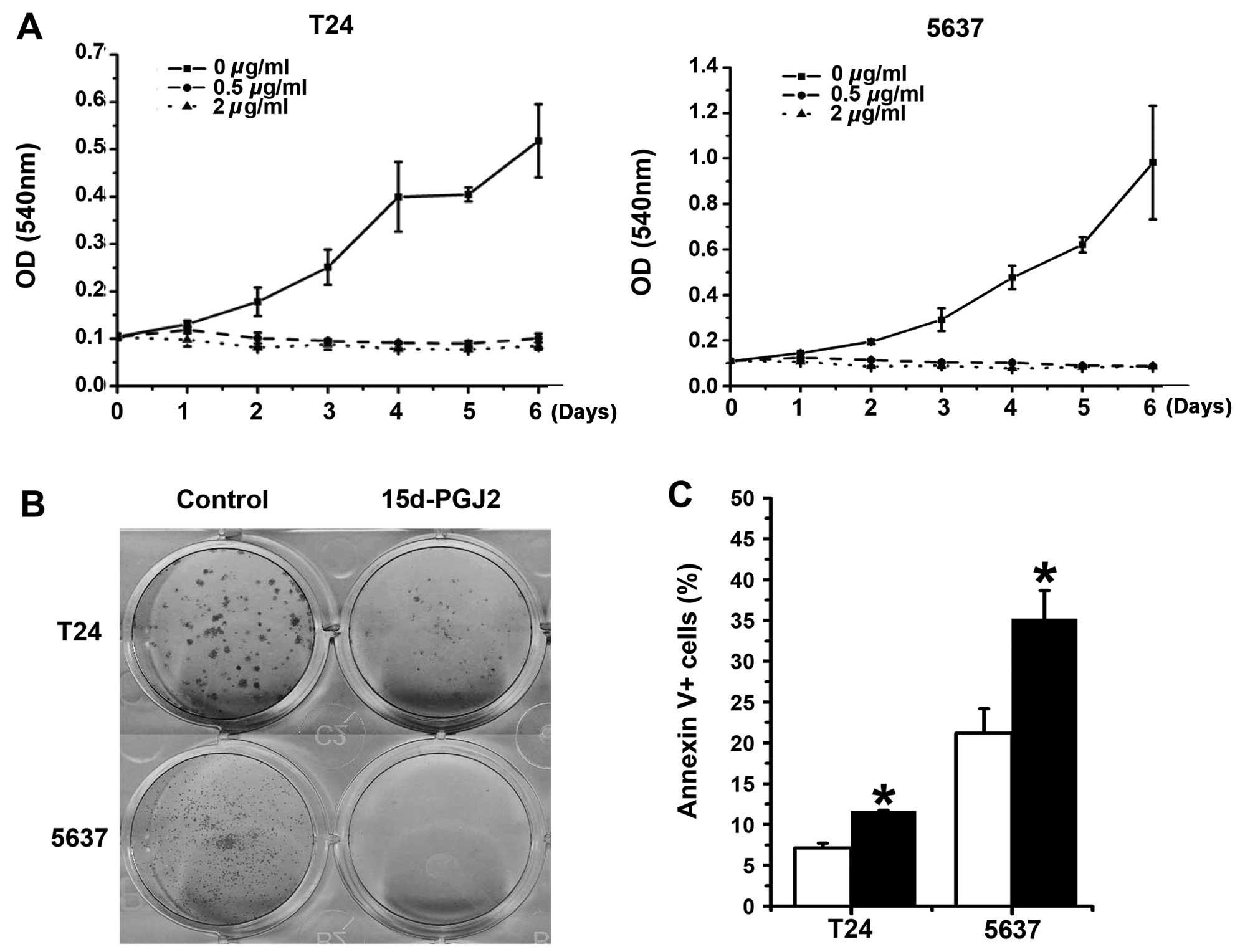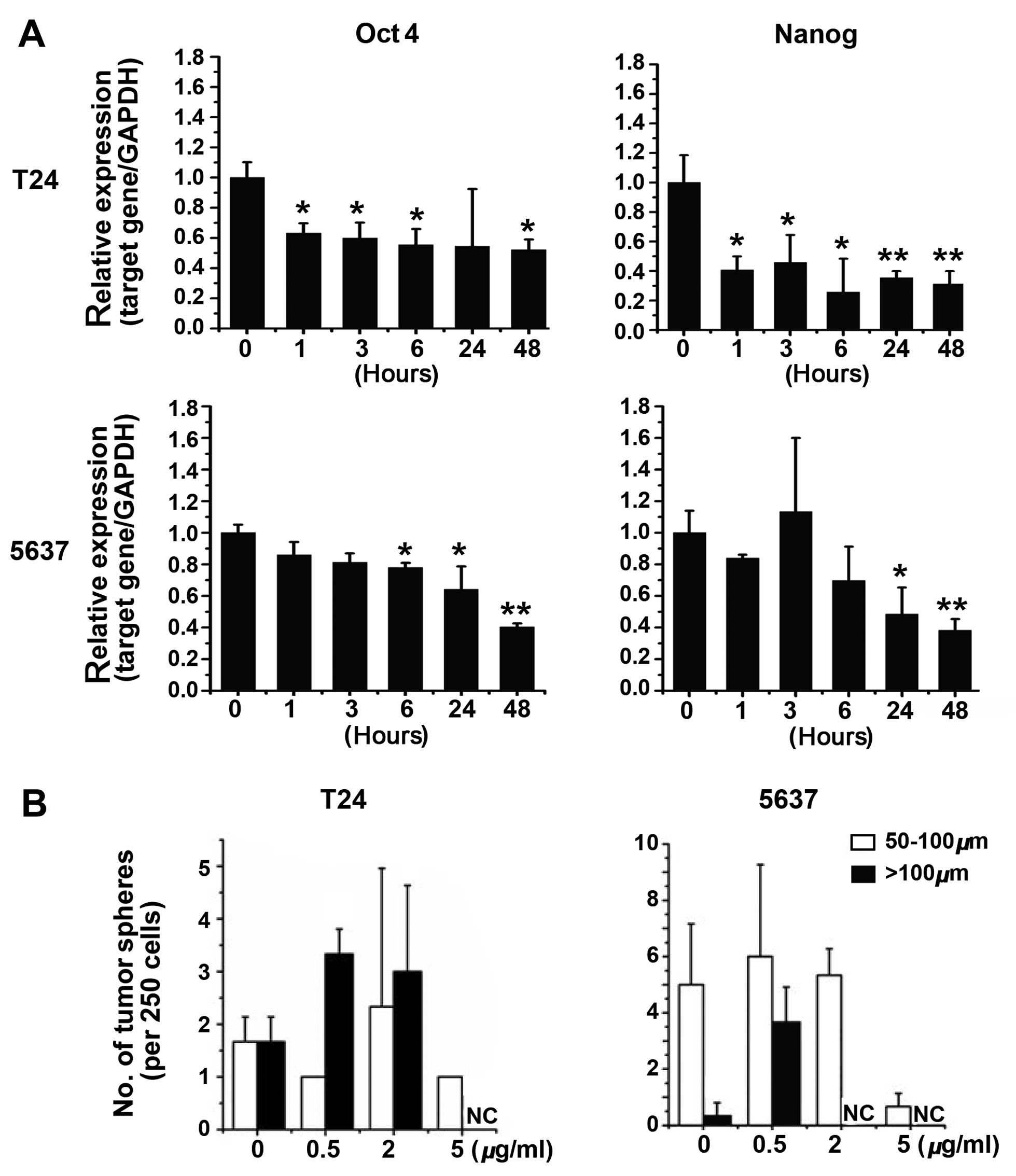|
1
|
Ploeg M, Aben KK and Kiemeney LA: The
present and future burden of urinary bladder cancer in the world.
World J Urol. 27:289–293. 2009. View Article : Google Scholar : PubMed/NCBI
|
|
2
|
Basile KJ and Aplin AE: Resistance to
chemotherapy: short-term drug tolerance and stem cell-like
subpopulations. Adv Pharmacol. 65:315–314. 2012. View Article : Google Scholar : PubMed/NCBI
|
|
3
|
Michalik L, Desvergne B and Wahli W:
Peroxisome-proliferator-activated receptors and cancers: complex
stories. Nat Rev Cancer. 4:61–70. 2004. View Article : Google Scholar : PubMed/NCBI
|
|
4
|
Sarraf P, Mueller E, Jones D, et al:
Differentiation and reversal of malignant changes in colon cancer
through PPARgamma. Nat Med. 4:1046–1052. 1998. View Article : Google Scholar : PubMed/NCBI
|
|
5
|
Chang TH and Szabo E: Induction of
differentiation and apoptosis by ligands of peroxisome
proliferator-activated receptor gamma in non-small cell lung
cancer. Cancer Res. 60:1129–1138. 2000.PubMed/NCBI
|
|
6
|
Keshamouni VG, Reddy RC, Arenberg DA, et
al: Peroxisome proliferator-activated receptor-γ activation
inhibits tumor progression in non-small-cell lung cancer. Oncogene.
23:100–108. 2004.
|
|
7
|
Chen YC, Shen SC and Tsai SH:
Prostaglandin D(2) and J(2) induce apoptosis in human leukemia
cells via activation of the caspase 3 cascade and production of
reactive oxygen species. Biochim Biophys Acta. 1743:291–304. 2005.
View Article : Google Scholar : PubMed/NCBI
|
|
8
|
Ray DM, Akbiyik F and Phipps RP: The
peroxisome proliferator-activated receptor gamma (PPARgamma)
ligands 15-deoxy-Delta12,14-prostaglandin J2 and ciglitazone induce
human B lymphocyte and B cell lymphoma apoptosis by
PPARgamma-independent mechanisms. J Immunol. 177:5068–5076. 2006.
View Article : Google Scholar
|
|
9
|
Girnun GD, Naseri E, Vafai SB, et al:
Synergy between PPARgamma ligands and platinum-based drugs in
cancer. Cancer Cell. 11:395–406. 2007. View Article : Google Scholar : PubMed/NCBI
|
|
10
|
Mansure JJ, Nassim R, Chevalier S, et al:
A novel mechanism of PPARγ induction via EGFR signalling
constitutes rational for combination therapy in bladder cancer.
PLoS One. 8:e559972013.
|
|
11
|
Liu L, Yang Z, Xu Y, et al: Inhibition of
oxidative stress-elicited AKT activation facilitates PPARγ
agonist-mediated inhibition of stem cell character and tumor growth
of liver cancer cells. PLoS One. 8:e730382013.PubMed/NCBI
|
|
12
|
Hanahan D and Weinberg RA: Hallmarks of
cancer: the next generation. Cell. 144:646–674. 2011. View Article : Google Scholar : PubMed/NCBI
|
|
13
|
Margulis V, Lotan Y and Shariat SF:
Survivin: a promising biomarker for detection and prognosis of
bladder cancer. World J Urol. 26:59–65. 2008. View Article : Google Scholar : PubMed/NCBI
|
|
14
|
Shariat SF, Ashfaq R, Karakiewicz PI, et
al: Survivin expression is associated with bladder cancer presence,
stage, progression, and mortality. Cancer. 109:1106–1113. 2007.
View Article : Google Scholar : PubMed/NCBI
|
|
15
|
Akhtar M, Gallagher L and Rohan S:
Survivin: role in diagnosis, prognosis, and treatment of bladder
cancer. Adv Anat Pathol. 13:122–126. 2006. View Article : Google Scholar : PubMed/NCBI
|
|
16
|
Atlasi Y, Mowla SJ and Ziaee SA:
Differential expression of survivin and its splice variants,
survivin-DeltaEx3 and survivin-2B, in bladder cancer. Cancer Detect
Prev. 32:308–313. 2009. View Article : Google Scholar : PubMed/NCBI
|
|
17
|
Chen X, Wang T, Yang D, et al: Expression
of the IAP protein family acts cooperatively to predict prognosis
in human bladder cancer patients. Oncol Lett. 5:1278–1284.
2013.PubMed/NCBI
|
|
18
|
Lee N, Oh J, Ban J, et al:
4-O-methylhonokiol, a PPARγ agonist, inhibits prostate tumour
growth: p21-mediated suppression of NF-κB activity. Br J Pharmacol.
168:1133–1145. 2013.PubMed/NCBI
|
|
19
|
Smallridge RC, Copland JA, Brose MS, et
al: Efatutazone, an oral PPAR-γ agonist, in combination with
paclitaxel in anaplastic thyroid cancer: results of a multicenter
phase 1 trial. J Clin Endocrinol Metab. 98:2392–2400. 2013.
|
|
20
|
Ban JO, Oh JH, Son SM, et al:
Troglitazone, a PPAR agonist, inhibits human prostate cancer cell
growth through inactivation of NFκB via suppression of GSK-3β
expression. Cancer Biol Ther. 12:288–296. 2011.PubMed/NCBI
|
|
21
|
Charytonowicz E, Terry M, Coakley K, et
al: PPARγ agonists enhance ET-743-induced adipogenic
differentiation in a transgenic mouse model of myxoid round cell
liposarcoma. J Clin Invest. 122:886–898. 2012.
|
|
22
|
Pestereva E, Kanakasabai S and Bright JJ:
PPARγ agonists regulate the expression of stemness and
differentiation genes in brain tumour stem cells. Br J Cancer.
106:1702–1712. 2012.
|
|
23
|
Pereira L, Igea A, Canovas B, et al:
Inhibition of p38 MAPK sensitizes tumour cells to cisplatin-induced
apoptosis mediated by reactive oxygen species and JNK. EMBO Mol
Med. 5:1759–1774. 2013. View Article : Google Scholar : PubMed/NCBI
|
|
24
|
Lambeth JD: NOX enzymes and the biology of
reactive oxygen. Nat Rev Immunol. 4:181–189. 2004. View Article : Google Scholar : PubMed/NCBI
|
|
25
|
Owusu-Ansah E and Banerjee U: Reactive
oxygen species prime Drosophila haematopoietic progenitors
for differentiation. Nature. 461:537–541. 2009. View Article : Google Scholar : PubMed/NCBI
|
|
26
|
Houseknecht KL, Cole BM and Steele PJ:
Peroxisome proliferator-activated receptor gamma (PPARgamma) and
its ligands: a review. Domest Anim Endocrinol. 22:1–23. 2002.
View Article : Google Scholar : PubMed/NCBI
|
|
27
|
Kersten S and Wahli W: Peroxisome
proliferator activated receptor agonists. EXS. 89:141–151.
2000.PubMed/NCBI
|
|
28
|
Koshiyama H, Shimono D, Kuwamura N, et al:
Rapid communication: inhibitory effect of pioglitazone on carotid
arterial wall thickness in type 2 diabetes. J Clin Endocrinol
Metab. 86:3452–3456. 2001. View Article : Google Scholar : PubMed/NCBI
|
|
29
|
Lehmann JM, Moore LB, Smith-Oliver TA, et
al: An antidiabetic thiazolidinedione is a high affinity ligand for
peroxisome proliferator-activated receptor gamma (PPAR gamma). J
Biol Chem. 270:12953–12956. 1995. View Article : Google Scholar : PubMed/NCBI
|
|
30
|
Su CG, Wen X, Bailey ST, et al: A novel
therapy for colitis utilizing PPAR-gamma ligands to inhibit the
epithelial inflammatory response. J Clin Invest. 104:383–389. 1999.
View Article : Google Scholar : PubMed/NCBI
|
|
31
|
Kondo T, Setoguchi T and Taga T:
Persistence of a small subpopulation of cancer stem-like cells in
the C6 glioma cell line. Proc Natl Acad Sci USA. 101:781–786. 2004.
View Article : Google Scholar : PubMed/NCBI
|
|
32
|
Salmaggi A, Boiardi A, Gelati M, et al:
Glioblastoma-derived tumorospheres identify a population of tumor
stem-like cells with angiogenic potential and enhanced multidrug
resistance phenotype. Glia. 54:850–860. 2006. View Article : Google Scholar
|
|
33
|
Ding W, Mouzaki M, You H, et al:
CD133+ liver cancer stem cells from methionine adenosyl
transferase 1A-deficient mice demonstrate resistance to
transforming growth factor (TGF)-beta-induced apoptosis.
Hepatology. 49:1277–1286. 2009.
|
|
34
|
Hermann PC, Huber SL, Herrler T, et al:
Distinct populations of cancer stem cells determine tumor growth
and metastatic activity in human pancreatic cancer. Cell Stem Cell.
1:313–323. 2007. View Article : Google Scholar : PubMed/NCBI
|
|
35
|
Reya T, Morrison SJ, Clarke MF and
Weissman IL: Stem cells, cancer, and cancer stem cells. Nature.
414:105–111. 2001. View
Article : Google Scholar : PubMed/NCBI
|
|
36
|
Kelly PN, Dakic A, Adams JM, et al: Tumor
growth need not be driven by rare cancer stem cells. Science.
317:3372007. View Article : Google Scholar : PubMed/NCBI
|
|
37
|
Adler V, Yin Z, Tew KD and Ronai Z: Role
of redox potential and reactive oxygen species in stress signaling.
Oncogene. 18:6104–6111. 1999. View Article : Google Scholar : PubMed/NCBI
|
|
38
|
Kondo M, Oya-Ito T, Kumagai T, et al:
Cyclopentenone prostaglandins as potential inducers of
intracellular oxidative stress. J Biol Chem. 276:12076–12083. 2001.
View Article : Google Scholar : PubMed/NCBI
|
|
39
|
Kim KY, Ahn JH and Cheon HG: Apoptotic
action of peroxisome proliferator-activated receptor-γ activation
in human non small-cell lung cancer is mediated via proline
oxidase-induced reactive oxygen species formation. Mol Pharmacol.
72:674–685. 2007.
|
|
40
|
Wang JJ and Mak OT: Induction of apoptosis
by 15d-PGJ2 via ROS formation: an alternative pathway
without PPARγ activation in non-small cell lung carcinoma A549
cells. Prostaglandins Other Lipid Mediat. 94:104–111.
2011.PubMed/NCBI
|
|
41
|
Shin SW, Seo CY, Han H, et al:
15d-PGJ2 induces apoptosis by reactive oxygen
species-mediated inactivation of Akt in leukemia and colorectal
cancer cells and shows in vivo antitumor activity. Clin Cancer Res.
15:5414–5425. 2009.
|
|
42
|
Ito K, Hirao A, Arai F, et al: Regulation
of oxidative stress by ATM is required for self-renewal of
haematopoietic stem cells. Nature. 431:997–1002. 2004. View Article : Google Scholar : PubMed/NCBI
|
|
43
|
Miyamoto K, Araki KY, Naka K, et al:
Foxo3a is essential for maintenance of the hematopoietic stem cell
pool. Cell Stem Cell. 1:101–112. 2007. View Article : Google Scholar : PubMed/NCBI
|
|
44
|
Tothova Z, Kollipara R, Huntly BJ, et al:
FoxOs are critical mediators of hematopoietic stem cell resistance
to physiologic oxidative stress. Cell. 128:325–339. 2007.
View Article : Google Scholar : PubMed/NCBI
|
|
45
|
Yalcin S, Zhang X, Luciano JP, et al:
Foxo3 is essential for the regulation of ataxia telangiectasia
mutated and oxidative stress-mediated homeostasis of hematopoietic
stem cells. J Biol Chem. 283:25692–25705. 2008. View Article : Google Scholar : PubMed/NCBI
|
|
46
|
Ghaffari S: Oxidative stress in the
regulation of normal and neoplastic hematopoiesis. Antioxid Redox
Signal. 10:1923–1940. 2008. View Article : Google Scholar : PubMed/NCBI
|
|
47
|
Alexandre J, Hu Y, Lu W, et al: Novel
action of paclitaxel against cancer cells: bystander effect
mediated by reactive oxygen species. Cancer Res. 67:3512–3517.
2007. View Article : Google Scholar : PubMed/NCBI
|
|
48
|
Bedard K and Krause KH: The NOX family of
ROS-generating NADPH oxidases: physiology and pathophysiology.
Physiol Rev. 87:245–313. 2007. View Article : Google Scholar : PubMed/NCBI
|
|
49
|
Zolezzi JM, Silva-Alvarez C, Ordenes D, et
al: Peroxisome proliferator-activated receptor (PPAR) γ and PPARα
agonists modulate mitochondrial fusion-fission dynamics: relevance
to reactive oxygen species (ROS)-related neurodegenerative
disorders? PLoS One. 8:e640192013.
|














